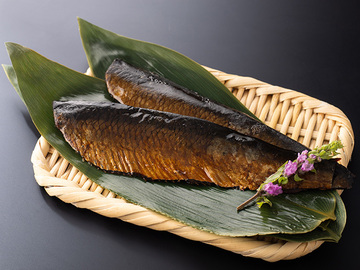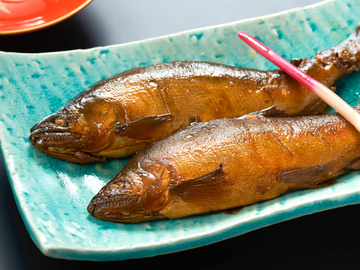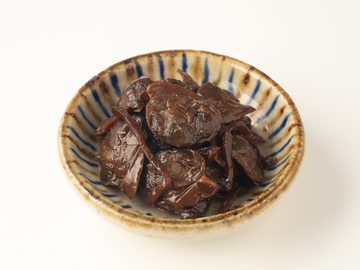Seasoned preserved foods

History and Culture
Seasoned processed foods are preserved seafoods or seaweeds prepared by processes to improve shelf life such as by immersing in thick seasoning liquid, or by simmering and/or drying the seasoned seafoods or seaweeds. The seasoning liquid is primarily made up of soy sauce, sugar, and salt. Improved preservation is achieved by the dehydrating effect of the thick seasoning liquid, decrease in water activity through simmering and/or drying, and heating sterilization.
There are various types of seasoned processed foods. The history of tsukudani dates back to the early modern times. It is considered that people of Tsukuda Village in Osaka moved to Edo and spread the recipe. Later, the production of tsukudani increased around the middle of the Showa period, and the food culture represented by tsukudani spread all over Japan.
Seasoned processed foods are classified into seasoned and boiled-down products (e.g., tsukudani), seasoned and dried products (e.g., mirin-boshi, furikake), seasoned smoke-dried products (e.g., grilled conger eel, shredded dried squid), and other (grilled clam).
The majority of seasoned processed foods represent the food culture developed in modern times and later, and there are a vast variety of products.
| Classification of seasoned processed foods (including non-traditional seasoned processed foods) | |
|---|---|
| Seasoned and boiled-down products | e.g., tsukudani, ameni, kanroni, shigureni, kanroni, suzume-yaki These are believed to be variant dishes evolved from tsukudani. |
| Seasoned and dried products | e.g., mirin-boshi (sakura-boshi), gisukeni, furikake, and denbu |
| Seasoned smoke-dried products | e.g., grilled conger eel (kabayaki), shredded dried squid, fish crackers, seasoned cod, grilled whole fish |
| Other | e.g., foodstuffs dressed with sea urchin, hamayaki-style sea bream, and grilled clam |
ed. Katsutoshi Mitsuhashi, "Suisan Kakohin Soran" [Comprehensive Guide to Processed Fishery Products])
Characteristics and Types
Seasoned processed foods are classified into three types and the details are summarized below.

[Seasoned and boiled-down products (e.g., tsukudani)]
The history of tsukudani began in Tsukuda Village in Osaka. Originally, fishermen produced preserved foods by boiling small fish with salt. In the Edo period, Ieyasu Tokugawa moved fishermen in Tsukuda Village to Edo, and tsukudani production in Edo started on a large scale. The area the fishermen settled in was named Tsukudajima after Tsukuda Village.
Today, various types of tsukudani dishes are available as local specialties in each region and distributed nationwide not only as foods with improved shelf life but also as specialty foods designed to match the unique preferences of individual consumers. Tsukudani are made from food such as kelp, short-neck clam, young lancefish, and nori.
Tsukudani is called differently depending on the ratio of seasonings: kanroni (rich in sugar and starch syrup), shigureni (ginger or other seasonings are used to add spicy flavor), and ameni (similar to kanroni, but has more intense sweetness by simmering with sugar, starch syrup, salt, and the like, instead of using soy sauce).

[Seasoned and dried products (e.g., mirin-boshi)]
Mirin-boshi is produced by removing the head, guts, and backbone, butterflying the fish, and immersing it in seasoning liquid primarily made of sugar, followed by drying. Mirin-boshi is also called "sakura-boshi" because the sakura (cherry blossom) season was the best season for the production, and dried butterflied fish resembles the shape of a cherry blossom petal.
[Seasoned smoke-dried products (e.g., grilled conger eel)]
Grilled conger eel is produced by opening a conger eel, removing the guts, and immersing it in seasoning liquid. Grilled conger eel is mainly produced in the Kansai region. It is not only consumed locally, but is also a popular souvenir.
Production Methods
The manufacturing methods for the three types of seasoned processed foods described above are outlined.
[Seasoned and boiled-down products (e.g., tsukudani)]
There are mainly two types of tsukudani production methods: irini and ukashini. For the irini method, the ingredient is immersed in the seasoning liquid before heating. This method is typically used for processing seaweeds and dried foods, which are resistant to disintegrate, and into which the seasoning liquid does not readily penetrate.
For the ukashini method, after being steamed and simmered, the ingredient is immersed in the seasoning liquid and simmered at low heat, and then cooked food is ladled out from the liquid. This method is useful when processing foods that readily disintegrate, such as seafoods.
[Seasoned and dried products (e.g., mirin-boshi)]
To cook mirin-boshi of sardines, frozen sardines are mainly used. From the defrosted sardines, the head, guts, and backbone are removed, and then butterflied. The butterflied pieces are immersed in the seasoning liquid. After sun-dried or machine-dried, the fish is then dried in cold air, and polysaccharides are applied onto the surface for glazing. During the drying process, the fish is topped with roasted sesame seeds or other toppings.
[Seasoned smoke-dried products (e.g., grilled conger eel)]
To prepare grilled conger eel, the conger eel is secured onto the cutting board, and opened using a knife. After removing the head, guts, backbone, gills, and the like, the fish is washed with fresh water, and skewered with bamboo skewers. After dipping in the seasoning liquid, the fish is grilled over charcoal. The timing of dipping and the ingredients vary greatly between cooks.
Relationship with Regions
Some of the seasoned processed foods that have connection with a region, or have characteristic production methods or history are presented below.

[Seasoned and boiled-down products (e.g., tsukudani, kanroni)]
In the food culture in the lakeshore areas of Biwako in Shiga Prefecture, lake fish is the source of protein. There is a custom of simmering fish caught in the morning, and tsukudani is cooked using sweetfish, isaza (Gymnogobius isaza), moroko (Gnathopogon caerulescens), gori (Rhinogobius). Sometimes the fish is cooked with soybeans.
In the lakeshore areas of Kasumigaura in Ibaraki Prefecture, tsukudani is cooked using Japanese smelt. There are many food manufacturers making the tsukudani of Japanese smelt, which is the local specialty.
In Ishikawa Prefecture, tsukudani is cooked using funa (Carassiusand) and gori (Fourspine sculpin). When processing funa, people used to use a special method in which funa packed in a basket is steamed in a steam kettle prior to immersing it in the seasoning liquid for the purpose of removing harsh taste. This was called funa no suzume-ni.
Other tsukudani products include herring rolled in kelp, a local specialty of Hokkaido, and ikanago no kugini, a local specialty of Hyogo Prefecture.
[Seasoned and dried products (e.g., mirin-boshi)]
Main production areas are Chiba Prefecture, Ibaraki Prefecture, and Toyama Prefecture. While sardine is the main ingredient, products using horse mackerel, shishamo, mackerel, and rockfish are also produced. They are mainly consumed in the Kansai and Chubu regions.
[Seasoned smoke-dried products (e.g., grilled conger eel)]
Production areas mainly in and around the Kansai region, including Hyogo Prefecture, Osaka Prefecture, and Hiroshima Prefecture. Harima-nada Sea is Japan's leading production area of conger eel, which is thought to be the reason that this traditional dish was developed. Traditionally, conger eels were grilled by hand, and manufactured one by one. However, the production has modernized with time, with there being a manufacturing method whereby conger eels are opened using a fish filleting machine, and heated with gas or electric heater.
Grilled skewed conger eel can be eaten as is, or used as maki-zushi (sushi rolls) or chirashi-zushi (scattered sushi).
Contribution to Sustainability and SDGs
The production methods, in which fishery food is immersed or simmered in the seasoning liquid, it is easier to impart unique characteristics with seasonings. Use of previously unused or nonstandard ingredients have become an added value, and the seasoned processed foods is drawing attention. Dried dashi kelp kombu and bonito flake, as well as garlic shoots and other foodstuffs that were discarded previously are used as ingredients.
(14. Life Below Water , 15. Life on Land)
In Japan, tsukudani of inago and other insects were traditional foods consumed in Nagano Prefecture and Gifu Prefecture in old times. The value of the food culture is re-discovered today.
(2. Zero Hunger)
Reference
Kenichi Kawasaki, Akihide Takiguchi, Seiji Noda, Masako Horikoshi, Tokiko Yaguchi, Kazutoyo Kanzaki, Akira Asano, Toshiro Mori, Takahiro Kashima, Hiroyasu Oka, Masako Ito, Tomohiro Ueda, and Heihachiro Takeda, edited by the Japanese Society of Traditional Food, "Nihon no Dento Shokuhin Jiten" [Encyclopedia of Traditional Japanese Food], Asakura Publishing Co., Ltd., p.371-404



